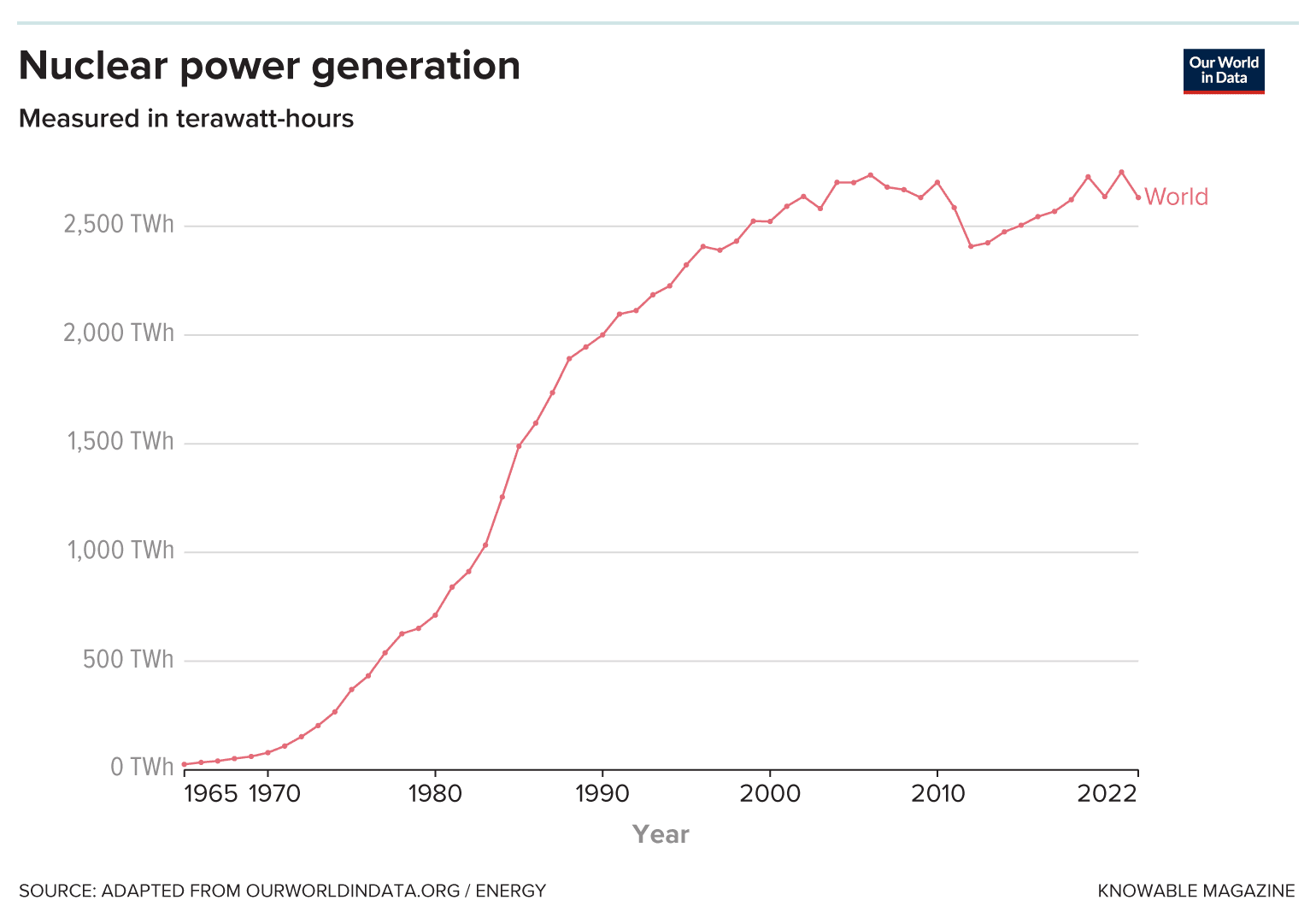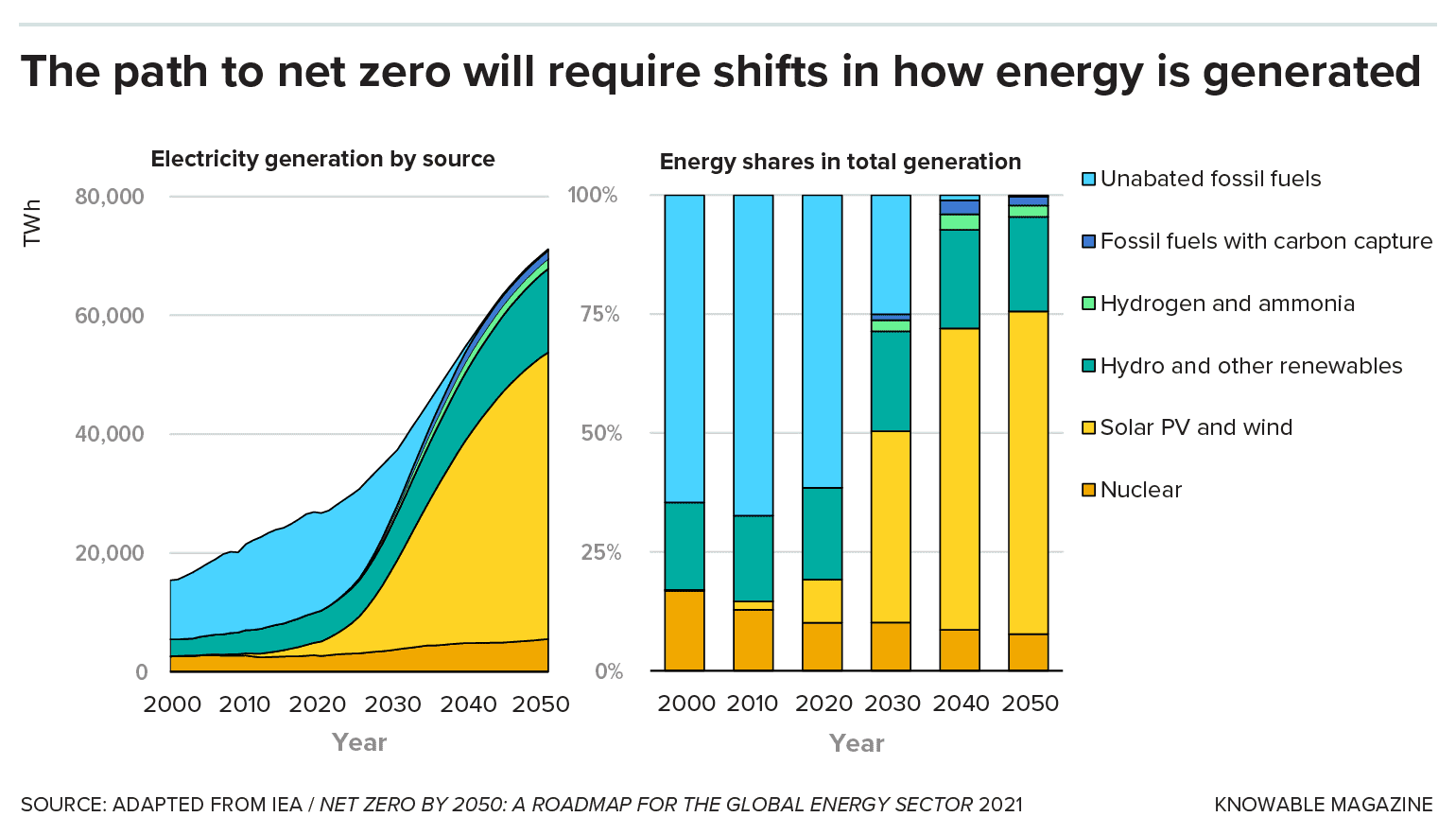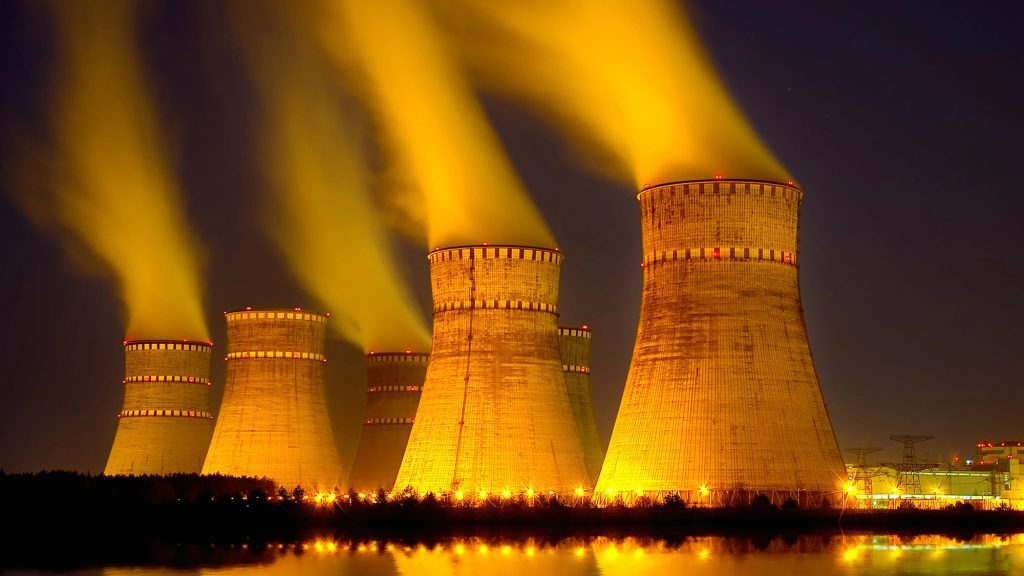This article was originally featured on Knowable Magazine.
In a video on the internet from Ultra Safe Nuclear Corporation, a cartoon demonstration illustrates a tsunami destroying one of their future nuclear power stations and disconnecting power. What happens next? Not much: The reactor quietly shuts itself down. The video reassures that the reactor cools off by simply sitting there, with no moving parts or fluids, and no operator actions. They have designed a reactor that is inherently safe regardless of the events.
Ultra Safe, based in Seattle, and many other companies like it are leading a global revival of nuclear energy. As the world urgently needs to move away from fossil fuels, reduce greenhouse gas emissions, and control the planet’s temperature, policymakers, companies, and researchers are reconsidering nuclear energy as a clean option that can help support the power generated by renewable sources like wind and solar. The industry is now emerging from a period of stagnation, with a commitment to double or triple its capacity by 2050.
This revival is supported by two popular technology trends. Companies like Ultra Safe aim to construct small modular reactors (SMRs) that are much smaller than previous plants, with the goal of reducing building costs and the potential for disasters. Many are also looking to use new technologies to prevent meltdown accidents and produce less long-lasting waste.
However, the increase in interest is not free from controversy. As with everything related to nuclear power, the debate continues about whether society truly needs nuclear energy to address climate change and whether the new systems are as impressive as they appear—with valid arguments for and against every claim and risk. Some believe the new technologies could provide an excellent solution to our energy problems; others believe that nuclear energy is burdened with so many environmental, social, and economic challenges that it should be abandoned in favor of other ways to meet the world's energy needs. The next few years will determine the path nuclear power takes in the world’s energy future. Francesca Giovannini, a nuclear policy expert at the Harvard Kennedy School, says, “This is a moment of truth.” Nuclear power will either succeed or the industry will be fundamentally finished over the next few decades. The outcome is uncertain.Ups and downs in nuclear power output problems Nuclear power carries obvious risks, such as meltdown accidents, diversion of nuclear fuel to weapons programs, environmental issues related to uranium mining, and challenges associated with storing nuclear waste. In the face of such concerns and shifting economics of energy production, nuclear power production began to stabilize in the early 2000s and even decreased briefly after the Fukushima power plant accident in 2011. Some countries, notably Germany, opted to completely close their nuclear programs. However, global nuclear power production is now beginning to rise again.
Currently, nuclear plants generate about 10 percent of global electricity, making nuclear energy the second largest source of non-fossil-fuel energy after hydropower. There are approximately 440 nuclear power plants operating worldwide; around 60 more are currently under construction, and about 100 are in the planning stages.
Nuclear power production increased quickly during the last few decades of the 20th century, then stayed at the same level. It might be getting ready for another big increase.
Most of scenarios by the Intergovernmental Panel on Climate Change for keeping the world from warming above 1.5 degrees Celsius involve some kind of growth in nuclear power capacity. In the International Energy Agency’s (IEA)
pathway to net zero

double or triple costs over power networks that include nuclear.Nuclear has many advantages: It produces no carbon emissions (and, counterintuitively, releases less radioactive uranium and other elements into the environment than burning coal does ). It requires a lot less land than renewable sources, a
significant point to consider . If the aim is to decarbonize quickly and with as little social pain as possible, “nuclear is essential,” according to Kai Vetter, a nuclear physicist at the University of California, Berkeley.At the UN’s Convention on Climate Change meeting in Dubai in December 2023, more than 20 nations signed a declaration to triple nuclear capacityby 2050. And money is being invested in this endeavor. In 2020, the US Department of Energy (DOE) notably provided $160 million for two demonstration plants to become operational by 2027. And in 2022, the European Union stated that some nuclear projects could be considered “green” similar to renewables, which opens the door to environmental financing mechanisms.
But as with nearly every issue related to nuclear power, the arguments supporting nuclear power also have their challengers. M.V. Ramana, a public policy expert at the University of British Columbia, is one of many who argue that baseload power is an outdated concept . They claim that a smart, varied, and flexible electric grid can ensure a reliable power supply by shifting power among sources and storage facilities.
And with the cost of renewablesdecreasing rapidly, today’s economic assessments about the relative costs of power sources may not hold much weight in the future.
Most scenarios for global net-zero greenhouse gas emissions by 2050 involve a role for nuclear power. According to projections from the International Energy Agency, the overall amount of power from nuclear will need to grow by 2050 to meet demands (left). However, because the world’s total energy demand is expected to rise significantly, nuclear’s share of all power generation may actually decrease (right). Then there is the matter of safety. The total number of lives lost from all nuclear power production up to now, while difficult to measure, is definitely much lower than the number of people who died due to air pollution from the burning of fossil fuels; a recent study

However, using the number of deaths as the only way to measure the effects of the nuclear industry may not fully capture its impacts. These also include the risk of accidents contaminating large areas of land, as well as various other effects related to activities such as mining and waste storage. Ramana has expressed this view. how the burden of these last issues falls disproportionately on Indigenous and disempowered communities, working against the goals of social justice. According to Ramana, nuclear power is not in line with the idea of a responsible and cleaner energy system.
Small and shiny: New nuclear technologies documented If we are to pursue nuclear power at the scale called for by the IEA, it will take a herculean effort. The IEA’s pathway requires the world to ramp up from building five big nuclear plants per year to 20 per year over the next decade. Big plants typically cost billions of dollars and come with big financial risks. Westinghouse Electric Company, for example, recently filed for bankruptcy in the face of billions of dollars of cost overruns during the construction of four nuclear plants in the United States. One plan for reducing those epic and prohibitive costs is to build
small modular reactors
, ranging from reactors that can be shipped on a truck and produce a couple of hundred megawatts, to tiny single-megawatt sizes that are more akin to hefty diesel generators. The modules could be pre-built in a factory and shipped to a site for installation. All this should make these reactors less frightening prospects for investors (though the end price per unit of electricity might wind up higher than that from a larger nuclear power plant).
A handful of SMRs are already in operation in Russia, China and India. Dozens more are in development. Canada has a national SMR action plan, and as of 2021 there were 10 SMR proposals under review (including one from Ultra Safe). But so far, the promise of enticingly low costs for SMR builds hasn’t materialized, says Granger Morgan, a physicist and codirector of the Center for Climate and Energy Decision Making at Carnegie Mellon. Morgan hascrunched the numbers
for nuclear in the US and was disappointed. “I thought SMRs were going to hold much more promise, but we can’t make the numbers wash,” he says.
That message was hammered home in November 2023 when the company NuScale scrapped its high-profile advanced plans to build an underground SMR in Idaho in the face of cost hikes. “Would it be nice to have nuclear? Yes absolutely,” says Morgan. “Will it be affordable? That’s very much an open question. Others argue that small isn’t always beautiful. While smaller plants present a smaller risk from smaller potential accidents, this strategy also means more plants overall, which means more facilities to protect against theft and terrorism. “You have way more fissile material dispersed; you will have to secure way more infrastructure,” says Giovannini. “I mean, that becomes a mess. Next generation nuclear
While some are focusing on making nuclear plants smaller, there’s a parallel movement to make them safer and more efficient. The next generation of reactor designs—Generation IV, in the industry’s lingo—includes a suite of six major reactor families, all very different from today’s standard, each with many possible variants under development. Much of the attention (particularly in the US) has been focused on three of these: high-temperature gas-cooled, molten salt and sodium-cooled.
The concepts behind these technologies, and even some early-stage power plants, have been around for many years. However, the new versions of these old ideas combine unique fuels and designs, promising to be safer, more effective and eco-friendly. “They’re doing all sorts of impressive, high-tech things,” says Morgan, who is confident that newer reactors can be made safer than old ones.
Most existing reactors are water-cooled uranium systems, which were chosen as the main technology mostly due to historical reasons. Like all reactor types, they have their advantages and disadvantages. They require high pressures to prevent their coolant waters from evaporating at typical operating temperatures around 300 degrees Celsius. And they are designed to work with relatively slow-moving neutrons—the subatomic particles that collide with nuclear fuel to start nuclear fission. Slow-moving neutrons are more likely to interact with fuel particles, but systems that use them are also limited in the kinds of fuels they can use. Catastrophe can occur if the fission reaction goes out of control or the reactor gets too hot and the core “melts down,” as happened at Three Mile Island, Chernobyl and Fukushima, releasing radiation into the environment.
The latest models of water-cooled reactors (sometimes called Gen III Plus, including many SMRs) use new design techniques to reduce the number of safety systems that require human intervention, aiming to stop accidents automatically. Gen IV reactors, however, use entirely different coolant materials, are usually designed to operate at higher, more efficient temperatures, and often use faster-speed neutrons that can convert the most prevalent natural isotopes of uranium into usable fuel, or even feed on nuclear waste.
For example, high-temperature gas-cooled reactors operate at temperatures up to 950°C, making them 20 to 33 percent more thermally efficient than water-cooled reactors. Since the core materials used in these reactors are typically stable up to 1,600°C, which is hotter than lava, there’s a large margin of safety. The reactor in Ultra Safe’s video is a SMR that falls into this category; its small size also helps with passive cooling. Ultra Safe also manufactures their own fuel pellets, encased in a unique material that they claim retains radioactive materials even in extreme conditions. They’re hoping to build their
first commercial micro-reactor
molten salt reactors
, both fuel and coolant are already liquid. So meltdowns, in the traditional sense, are impossible. And liquid-sodium-cooled reactors have a built-in safety feature: If they heat up, the liquid sodium expands and allows more neutrons to escape through the gaps between atoms, so the reaction (which is driven by neutrons) naturally winds down. The US Department of Energy has funded the US company TerraPower (which has Bill Gates as a major investor) to build a demonstration plant of its sodium-cooled Natrium reactor in Wyoming by 2030. Nuclear waste not, want not in Canada.
In Waste is one area where the new designs really see some significant improvements, says Giovannini. “None of the reactors have entirely solved the problem of nuclear waste, but they do provide some significant solutions in terms of quantity,” she says. The spent fuel from traditional light water reactors needs to be buried in special repositories for hundreds of thousands of years, because of the production of long-lived radioactive byproducts. Some Gen IV reactors, on the other hand, can transform spent fuel into more fissile isotopes and use it for further fission reactions. This can improve efficiency and produce waste that need only be stored for hundreds of years.Not everyone, though, thinks all these systems are as impressive as they appear. In 2021, the Union of Concerned Scientists published a report called “'
Advanced’ Isn’t Always Better
”, in which they pointed out problems with safety, sustainability, and nuclear proliferation. They stated that almost all the Gen IV reactor types “don't offer significant enough improvements over [light water reactors] to justify their considerable risks.”
The report was criticized by some for being ideologically against nuclear power, says Giovannini. But, she says, “it was very fair” to highlight that new technology brings new concerns. The report mentioned that liquid salt is corrosive and that liquid sodium metal can burst into flame when in contact with water or air. The report also concluded that high-temperature gas-cooled reactors, while able to tolerate high temperatures, are “far from meltdown-proof, as some claim.”Many of these Gen IV systems offer another important advantage: Their higher temperatures can provide not only electricity but also useful heat. This heat could be used in various industrial processes, such as the production of steel, cement, and fertilizer, which currently rely heavily on burning fossil fuels in their furnaces.“That heat is pretty much for free,” says Vetter, who sees a particular use for nuclear heat in desalination, obtaining clean drinking water from saltwater as is done at the Diablo Canyon nuclear power plant in California. Indeed, X-energy, a leading US Gen IV nuclear company funded by the DOE, has partnered with Dow chemical company to construct its first high-temperature gas-cooled reactor at a Dow chemical production site by 2030. However, Morgan believes that most industries will hesitate due to the setup costs.
Even if Gen IV reactors prove to be technically superior, it may take decades before they can be thoroughly tested, approved by regulators, and built on a commercial scale. With limited time to combat climate change, the world might be better off simply increasing the use of old reactor designs that are already proven, says Esam Hussein, a retired nuclear engineer from the University of Regina, Canada.
Hot idea
“We have the operating experience, we have the regulatory framework,” he says. “If the goal is to fight climate change, why don’t you go with the devil you know?”
In response to why we need a devil at all, many are quick to point out that no energy solution is problem-free, including renewables. Giovannini says she agrees with the nuclear industry’s criticism that we have “embraced renewables in a very uncritical way.” Wind and solar require electronics and battery banks to store their energy; these in turn require elements like lithium and cobalt that can have environmental and social justice issues from mining. “Nothing is 100 percent safe,” says Vetter.
It is difficult for many to accept data, assurances, and statistics about nuclear power, given its history and the significant amounts of money involved. “I think the nuclear industry is selling a bunch of nonsense most of the time,” says Giovannini, who has been critical
of how the industry deals with public concerns. But her main concern about nuclear power is that “they’re moving too slowly.” If companies like Ultra Safe, X-Energy, TerraPower, and others are going to help combat climate change with Gen IV technologies and fleets of small reactors, she and others say, they’re going to have to accelerate rapidly.
This article was first published in Knowable Magazine Knowable Magazine Is nuclear power a vital component of the shift from fossil fuels? While the discussion continues, advancements in technology and smaller reactors may be changing the situation.
This article originally appeared in Knowable Magazine









